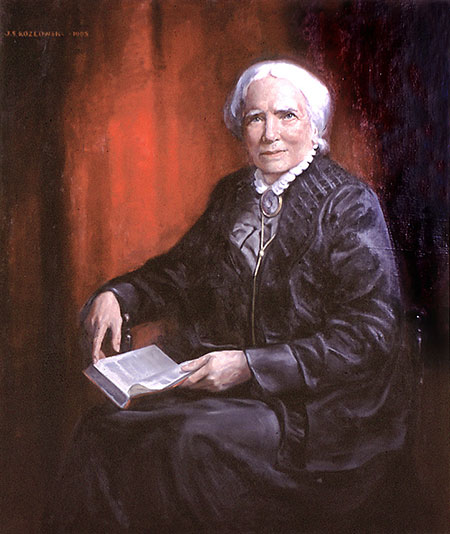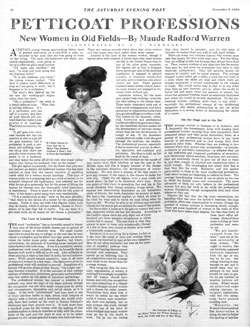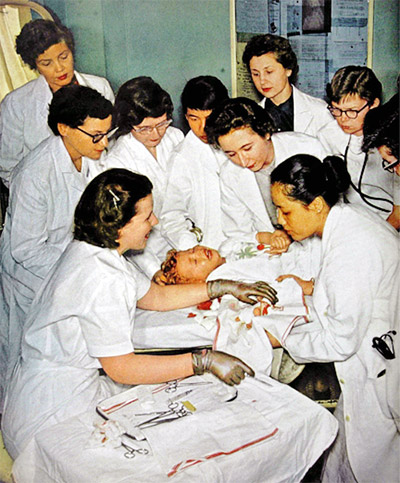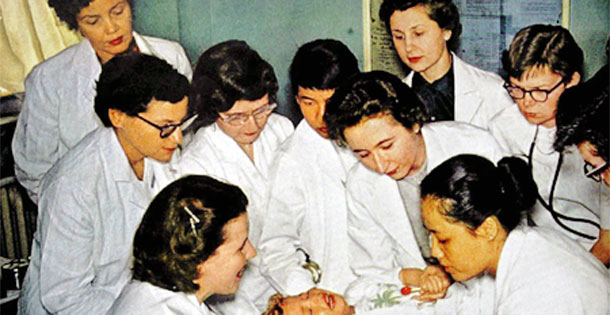
In May of 1849, a New York paper The National Era reported that Elizabeth Blackwell graduated from medical school. “Some of our male readers may be astonished to see an M. D. attached to the name of one of the gentler sex,” the editors wrote, “but we hope the time will come when an American woman, at least, can follow any honorable professional occupation … without exciting the surprise of any one.”
The editors might have been surprised to see how long it took for that time to arrive. Elizabeth Blackwell might have been the first woman in the U.S. to graduate from medical school, but her achievement barely opened the doors of the medical profession to women.
Dr. Blackwell found herself blocked from practicing at any hospital or clinic in New York City. In order to apply her medical education, she opened her own clinic for impoverished women. Later, she joined with two other women doctors to expand the clinic, creating the New York Infirmary for Women and Children in 1857.
Despite the resistance of many male doctors to female physicians, several cities began building medical schools for women. Women who’d become interested in the medicine from tending the wounded during the Civil War began applying to these schools in the 1870s. Over the next 10 years, the number of women doctors in America rose 347 percent. By 1880, over 2,400 women were practicing medicine in America
But women doctors still faced the same lack of cooperation from male colleagues that Blackwell had known. Male doctors would refuse to allow a doctor to attend their clinical trainings in hospital wards or to join their medical societies. Some refused to even work with nurses trained by women doctors.
In 1910, Maude Warren wrote an article for the Post on women’s progress in the professions. In general, she thought women’s prospects in the new century looked promising. Over 13,000 women were working as doctors in America. But this was still only 5 percent of all the doctors in America and, Warren wrote, “their numbers are not increasing.”

She offered several explanations for the decline. There was less need for doctors, male or female, in the healthy new decade. “The world is not so sick as it was. School hygiene, public baths and parks, and other preventive measures and social betterments are making doctors less necessary. Typhoid diphtheria, and malaria are rarer than they were; yellow fever and smallpox have had their day; and improved surgery has decreased the number of chronic invalids.”
She believed there would continue to be a demand for women doctors. “Women and children have grown to want them. And they will always succeed because of their infinite capacity for taking pains, their talent for endless detail, and their sympathy.
Perhaps America was becoming a healthier place to live, but that still didn’t explain the token percentage of women allowed to practice medicine. Whatever factors limited the number of women in medicine, it appeared to be highly consistent. In 1950 — a century after Elizabeth Blackwell received her medical degree— the percentage of female doctors still hovered at 6 percent. Boston had fewer women doctors in 1950 than it did in 1890.

In 1948, a Post article, “Do Women Make Good Doctors?” noted the continuing rejection of female doctors by their male colleagues. The article reported the “amusingly transparent” tricks used by some male doctors to keep women out of their specialties. “The New York Obstetrical Society … in spite of the nature of its specialty, does not admit women physicians to membership … because the society holds its meetings in the Yale Club, through whose sacred portals no women may enter.” Boston’s Obstetrical Society didn’t have this limitation to its meetings; it simply didn’t elect women into its organization. “Even a great many maternity hospitals do not have women doctors on their staffs.”
This marginalizing of women might have continued indefinitely, but a number of forces combined to break down the professional barriers in 1970s. First, a group called the Women’s Equity Action League brought a class action suit against every medical school in America receiving federal aid. It claimed the schools had discriminated against women in the recruiting and admissions process. Two years later, the federal government passed an amendment to the Higher Education Act. Title IX prohibits any education program from discriminating against any person on the basis of gender.
The combination of the two actions finally knocked down the obstacles that had persisted for over a century. By 1976, the number of women in medical school had risen 300 percent above the 1960 figure.
Today, about half of all medical students are female, and more than 30 percent of American doctors are women. These percentages are expected to rise. But it would be naive to think that all opposition to women in medicine has disappeared.
Become a Saturday Evening Post member and enjoy unlimited access. Subscribe now




Comments
Really fascinating article on female doctors and their struggles to get where they are today. Dr. Blackwell is a true pioneer in this field that people today should be aware of. Aside from her medical skills, she had to have a lot of other talents to accomplish what she did by 1857, which was/is astounding. I can only begin to comprehend the endless obstacles she faced.
I’m glad women today have the opportunities Dr. Blackwell helped make possible. I was surprised that there were fewer women doctors in 1950 than there were in 1890. Fortunately since the ’70s that’s changed. Long time POST readers are certainly familiar with Dr. Cory SerVaas,M.D. and her helpful medical advice.